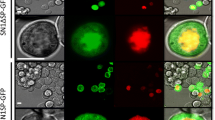Abstract
Bioassay screening of Bacillus thuringiensis culture supernatants identified strain EG2158 as having larvicidal activity against Colorado potato beetle (Leptinotarsa decemlineata) larvae. Ion-exchange fractionation of the EG2158 culture supernatant resulted in the identification of a protein designated Sip1A (secreted insecticidal protein) of approximately 38 kDa having activity against Colorado potato beetle (CPB). An oligonucleotide probe based on the N-terminal sequence of the purified Sip1A protein was used to isolate the sip1A gene. The sequence of the Sip1A protein, as deduced from the sequence of the cloned sip1A gene, contained 367 residues (41,492 Da). Recombinant B. thuringiensis and Escherichia coli harboring cloned sip1A produced Sip1A protein which had insecticidal activity against larvae of CPB, southern corn rootworm (Diabrotica undecimpunctata howardi), and western corn rootworm (Diabrotica virgifera virgifera).






Similar content being viewed by others
References
Aronson AI, Tyrell DJ, Fitz-James PC, Bulla LA Jr (1982) Relationship of the syntheses of spore coat protein and parasporal crystal protein in Bacillus thuringiensis. J Bacteriol 151:399–410
Baum JA, Coyle DM, Gilbert MP, Jany CS, Gawron-Burke MC (1990) Novel cloning vectors for Bacillus thuringiensis. Appl Environ Microbiol 56:3420–3428
de Maagd RA, Bravo A, Berry C, Crickmore N, Schnepf, HE (2003) Structure, diversity, and evolution of protein toxins from spore-forming entomopathogenic bacteria. Annu Rev Genet 37:409–433
Donovan WP, Gonzalez JM Jr, Gilbert MP, Dankocsik C (1988a) Isolation and characterization of EG2158, a new strain of Bacillus thuringiensis toxic to coleopteran larvae, and nucleotide sequence of the toxin gene. Mol Gen Genet 214:365–372
Donovan WP, Dankocsik CC, Gilbert MP, Gawron-Burke MC, Groat RG, Carlton BC (1988b) Amino acid sequence and entomocidal activity of the P2 crystal protein, an insect toxin from Bacillus thuringiensis var. kurstaki. J Biol Chem 263:561–567
Donovan WP, Rupar MJ, Slaney AC, Malvar T, Gawron-Burke MC, Johnson TB (1992) Characterization of two genes encoding Bacillus thuringiensis insecticidal crystal proteins toxic to Coleoptera species. Appl Environ Microbiol 58:3921–3927
Donovan WP, Donovan JC, Engleman JT (2001) Gene knockout demonstrates that Vip3A contributes to the pathogenesis of Bacillus thuringiensis toward Agrotis ipsilon and Spodoptera exigua. J Invertebr Pathol 78:45–51
Du C, Nickerson KW (1996) Bacillus thuringiensis HD-73 spores have surface-localized Cry1Ac toxin: physiological and pathogenic consequences. Appl Environ Microbiol 62:3722–3726
Estruch JJ, Warren GW, Mullins MA, Nye G J, Craig JA, Koziel MG (1996) Vip3A, a novel Bacillus thuringiensis vegetative insecticidal protein with a wide spectrum of activities against lepidopteran insects. Proc Natl Acad Sci U S A 93:5389–5394
Johnson DE, McGaughey WH (1996) Contribution of Bacillus thuringiensis spores to toxicity of purified Cry proteins towards Indianmeal moth larvae. Curr Microbiol 33:54–59
Johnson TB, Slaney AC, Donovan WP, Rupar MJ (1993) Insecticidal activity of EG4961, a novel strain of Bacillus thuringiensis toxic to larvae and adults of southern corn rootworm (Coleoptera: Chrysomelidae) and Colorado potato beetle (Coleoptera: Chrysomelidae). J Econ Entomol 86:330–333
Johnson DE, Oppert B, McGaughey WH (1998) Spore coat protein synergizes Bacillus thuringiensis crystal toxicity for the Indianmeal moth (Plodia interpunctella). Curr Microbiol 36:278–282
Li RS, Jarrett P, Burges HD (1987) Importance of spores, crystals and d-endotoxins in the pathogenicity of different varieties of Bacillus thuringiensis in Galleria mellonella and Pieris brassicae. J Invertebr Pathol 50:277–284
Liu JW, Porter AG, Wee BY, Thanabalu T (1996) New gene from nine Bacillus sphaericus strains encoding highly conserved 35.8-kilodalton mosquitocidal toxins. Appl Environ Microbiol 62:2174–2176
Liu Y, Tabashnik BE, Moar WJ, Smith RA (1998) Synergism between Bacillus thuringiensis spores and toxins against resistant and susceptible diamondback moths (Plutella xylostella). Appl Environ Microbiol 64:1385–1389
Moar WJ, Trumble JT, Federici BA (1989) Comparative toxicity of spores and crystals from the NRD-12 and HD1 strains of Bacillus thuringiensis subsp. kurstaki to neonate beet armyworm (Lepidoptera; Noctuidae). J Econ Entomol 82:1593–1603
Nielsen H, Engelbrecht J, Brunak S, von Heijne G (1997) Identification of prokaryotic and eukaryotic signal peptides and prediction of their cleavage sites. Protein Eng 10:1–6
Schnepf E, Crickmore N, Van Rie J, Lereclus D, Baum J, Feitelson J, Zeigler DR, Dean DH (1998) Bacillus thuringiensis and its pesticidal crystal proteins. Microbiol Mol Biol Rev 62:775–806
Somerville HJ, Tanada Y, Omi EM (1970) Lethal effect of purified spore and crystalline endotoxin preparations of Bacillus thuringiensis on several lepidopterous insects. J Invertebr Pathol 16:241–248
Tan Y, Donovan WP (2001) Deletion of aprA and nprA genes for alkaline protease A and neutral protease A from Bacillus thuringiensis: effect on insecticidal crystal proteins. J Biotechnol 84:67–72
Author information
Authors and Affiliations
Corresponding author
Rights and permissions
About this article
Cite this article
Donovan, W.P., Engleman, J.T., Donovan, J.C. et al. Discovery and characterization of Sip1A: a novel secreted protein from Bacillus thuringiensis with activity against coleopteran larvae. Appl Microbiol Biotechnol 72, 713–719 (2006). https://doi.org/10.1007/s00253-006-0332-7
Received:
Revised:
Accepted:
Published:
Issue Date:
DOI: https://doi.org/10.1007/s00253-006-0332-7




